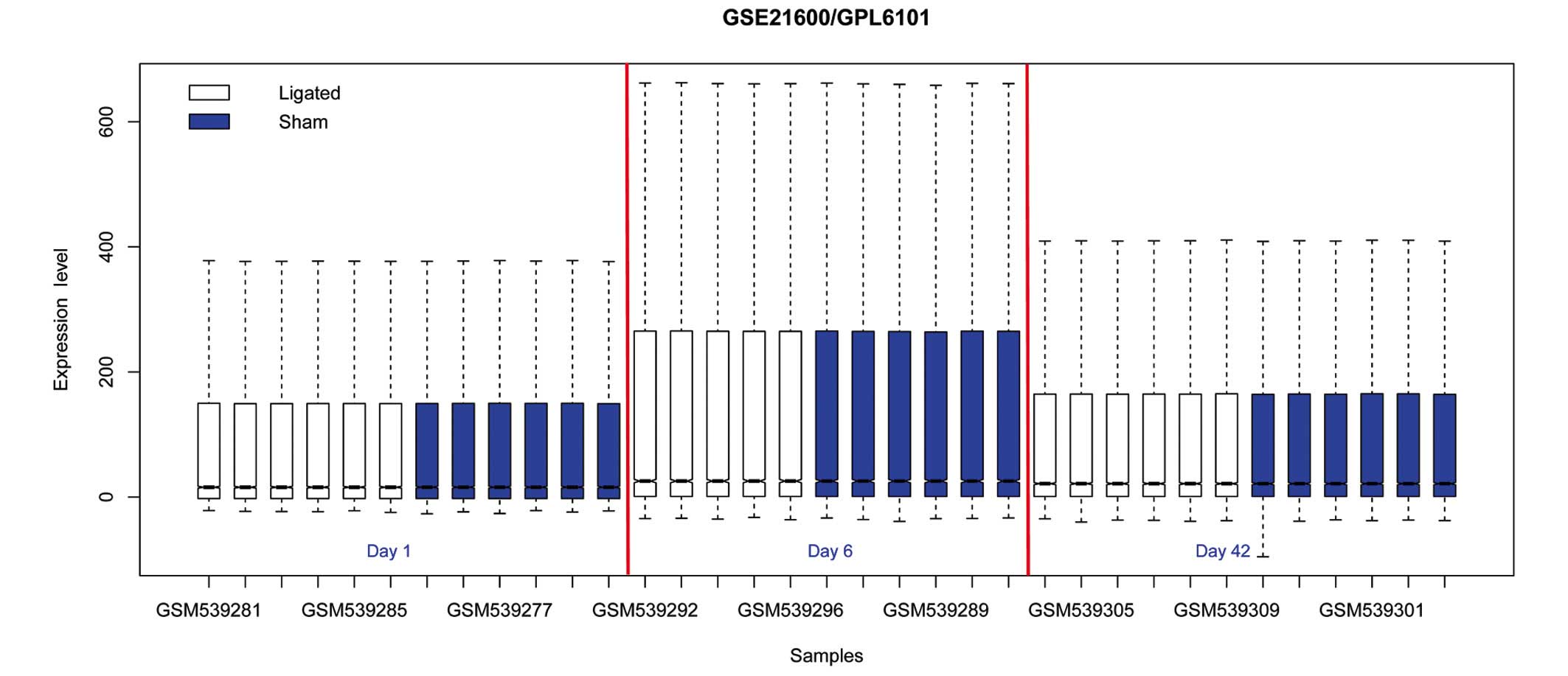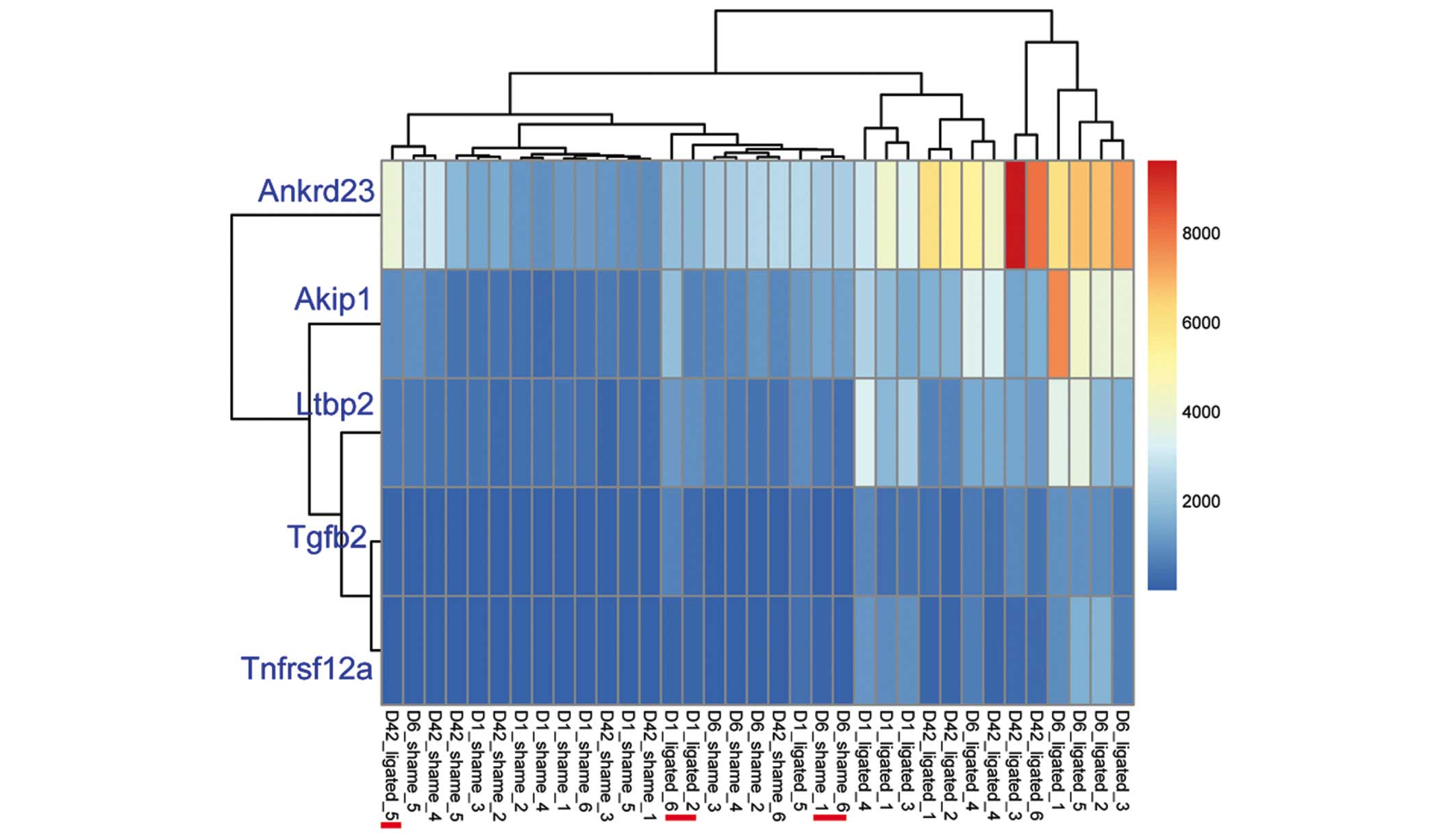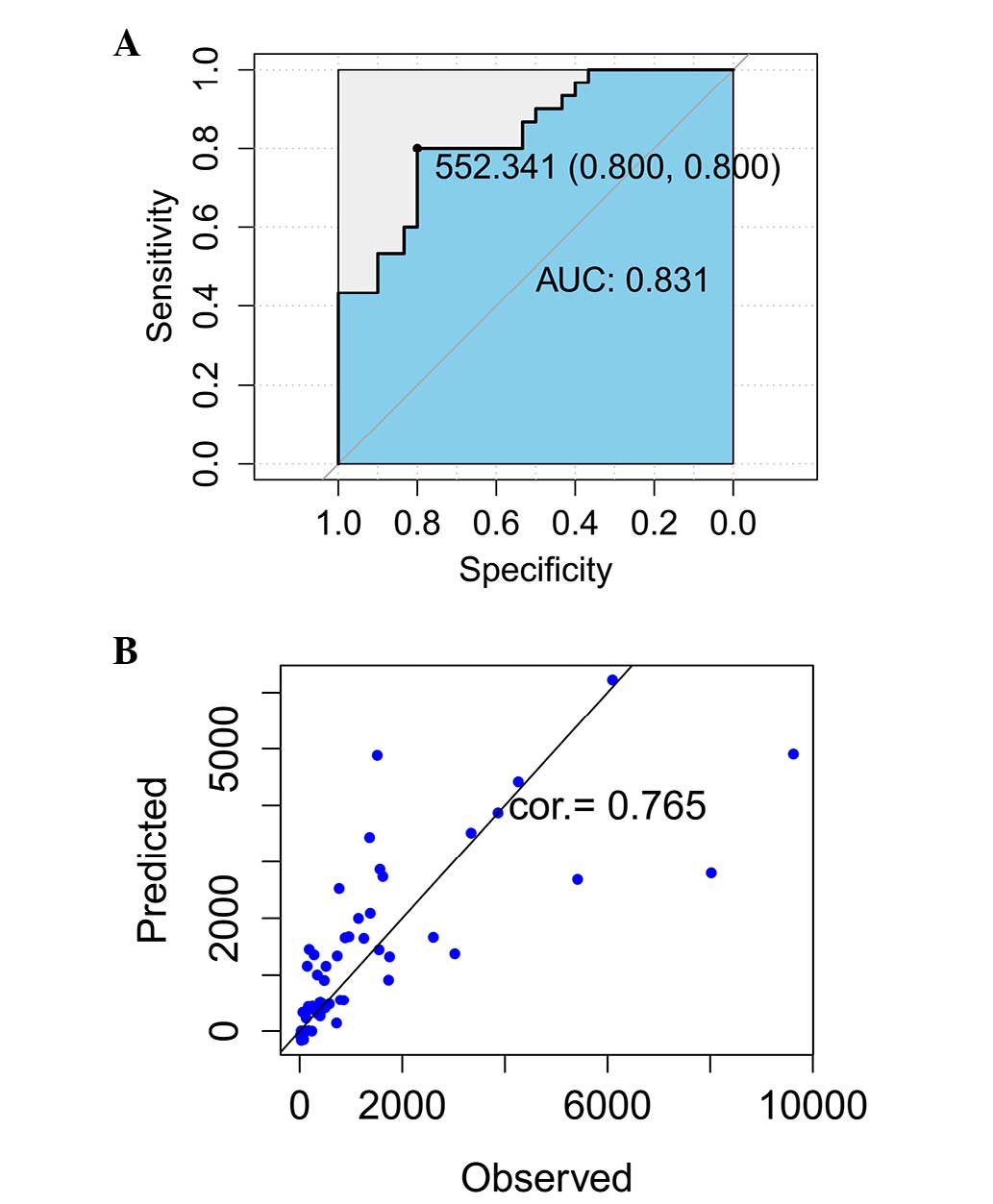|
1
|
Heineke J and Molkentin JD: Regulation of
cardiac hypertrophy by intracellular signalling pathways. Nat Rev
Mol Cell Biol. 7:589–600. 2006. View
Article : Google Scholar : PubMed/NCBI
|
|
2
|
Hubert HB, Feinleib M, McNamara PM and
Castelli WP: Obesity as an independent risk factor for
cardiovascular disease: A 26-year follow-up of participants in the
Framingham Heart Study. Circulation. 67:968–977. 1983. View Article : Google Scholar : PubMed/NCBI
|
|
3
|
Wang AY, Wang M, Woo J, Lam CW, Lui SF, Li
PK and Sanderson JE: Inflammation, residual kidney function and
cardiac hypertrophy are interrelated and combine adversely to
enhance mortality and cardiovascular death risk of peritoneal
dialysis patients. J Am Soc Nephrol. 15:2186–2194. 2004. View Article : Google Scholar : PubMed/NCBI
|
|
4
|
Dunn FG, Burns JM and Hornung RS: Left
ventricular hypertrophy in hypertension. Am Heart J. 122:312–315.
1991. View Article : Google Scholar : PubMed/NCBI
|
|
5
|
Osio A, Tan L, Chen SN, Lombardi R, Nagueh
SF, Shete S, Roberts R, Willerson JT and Marian AJ: Myozenin 2 is a
novel gene for human hypertrophic cardiomyopathy. Circ Res.
100:766–768. 2007. View Article : Google Scholar : PubMed/NCBI
|
|
6
|
Kontaraki JE, Parthenakis FI, Patrianakos
AP, Karalis IK and Vardas PE: Altered expression of early cardiac
marker genes in circulating cells of patients with hypertrophic
cardiomyopathy. Cardiovasc Pathol. 16:329–335. 2007. View Article : Google Scholar : PubMed/NCBI
|
|
7
|
Black FM, Packer SE, Parker TG, Michael
LH, Roberts R, Schwartz RJ and Schneider MD: The vascular smooth
muscle alpha-actin gene is reactivated during cardiac hypertrophy
provoked by load. J Clin Invest. 88:1581–1588. 1991. View Article : Google Scholar : PubMed/NCBI
|
|
8
|
Qing YF, Zhou JG, Zhang QB, Wang DS, Li M,
Yang QB, Huang CP, Yin L, Pan SY, Xie WG, et al: Association of
TLR4 Gene rs2149356 polymorphism with primary gouty arthritis in a
case-control study. PLoS One. 8:e648452013. View Article : Google Scholar : PubMed/NCBI
|
|
9
|
Planavila A, Redondo I, Hondares E,
Vinciguerra M, Munts C, Iglesias R, Gabrielli LA, Sitges M, Giralt
M, van Bilsen M and Villarroya F: Fibroblast growth factor 21
protects against cardiac hypertrophy in mice. Nat Commun.
4:20192013. View Article : Google Scholar : PubMed/NCBI
|
|
10
|
Grimwade D, Walker H, Oliver F, Wheatley
K, Harrison C, Harrison G, Rees J, Hann I, Stevens R, Burnett A and
Goldstone A: The importance of diagnostic cytogenetics on outcome
in AML: Analysis of 1,612 patients entered into the MRC AML 10
trial. The medical research council adult and children's leukaemia
working parties. Blood. 92:2322–2333. 1998.PubMed/NCBI
|
|
11
|
Covert MW, Schilling CH and Palsson B:
Regulation of gene expression in flux balance models of metabolism.
J Theor Biol. 213:73–88. 2001. View Article : Google Scholar : PubMed/NCBI
|
|
12
|
Wade KC, Guttentag SH, Gonzales LW,
Maschhoff KL, Gonzales J, Kolla V, Singhal S and Ballard PL: Gene
induction during differentiation of human pulmonary type II cells
in vitro. Am J Respir Cell Mol Biol. 34:727–737. 2006. View Article : Google Scholar : PubMed/NCBI
|
|
13
|
Saban MR, Hellmich H, Nguyen NB, Winston
J, Hammond TG and Saban R: Time course of LPS-induced gene
expression in a mouse model of genitourinary inflammation. Physiol
Genomics. 5:147–160. 2001.PubMed/NCBI
|
|
14
|
Tamayo P, Slonim D, Mesirov J, Zhu Q,
Kitareewan S, Dmitrovsky E, Lander ES and Golub TR: Interpreting
patterns of gene expression with self-organizing maps: Methods and
application to hematopoietic differentiation. Proc Natl Acad Sci
USA. 96:2907–2912. 1999. View Article : Google Scholar : PubMed/NCBI
|
|
15
|
Kondo S and Miura T: Reaction-diffusion
model as a framework for understanding biological pattern
formation. Science. 329:1616–1620. 2010. View Article : Google Scholar : PubMed/NCBI
|
|
16
|
Hellman U, Mörner S, Engström-Laurent A,
Samuel JL and Waldenström A: Temporal correlation between
transcriptional changes and increased synthesis of hyaluronan in
experimental cardiac hypertrophy. Genomics. 96:73–81. 2010.
View Article : Google Scholar : PubMed/NCBI
|
|
17
|
Revell LJ: Size-correction and principal
components for interspecific comparative studies. Evolution.
12:3258–3268. 2009. View Article : Google Scholar
|
|
18
|
Gennebäck N, Malm L, Hellman U,
Waldenström A and Mörner S: Using OPLS-DA to find new hypotheses in
vast amounts of gene expression data-Studying the progression of
cardiac hypertrophy in the heart of aorta ligated rat. Gene.
522:27–36. 2013. View Article : Google Scholar : PubMed/NCBI
|
|
19
|
Troyanskaya O, Cantor M, Sherlock G, Brown
P, Hastie T, Tibshirani R, Botstein D and Altman RB: Missing value
estimation methods for DNA microarrays. Bioinformatics. 17:520–525.
2001. View Article : Google Scholar : PubMed/NCBI
|
|
20
|
Fujita A, Sato JR, de Rodrigues LO,
Ferreira CE and Sogayar MC: Evaluating different methods of
microarray data normalization. BMC Bioinformatics. 7:4692006.
View Article : Google Scholar : PubMed/NCBI
|
|
21
|
Smyth GK Limma: Linear models for
microarray data. Bioinformatics and computational biology solutions
using R and Bioconductor. Gentleman R, Carey V, Huber W, Irizarry R
and Dudiot S: Springer-Verlag London Ltd. (London). 397–420. 2005.
View Article : Google Scholar
|
|
22
|
Benjamini Y and Hochberg Y: Controlling
the false discovery rate: A practical and powerful approach to
multiple testing. J R Statist Soc B. 57:289–300. 1995.
|
|
23
|
Eisen MB, Spellman PT, Brown PO and
Botstein D: Cluster analysis and display of genome-wide expression
patterns. Proc Natl Acad Sci USA. 95:14863–14868. 1998. View Article : Google Scholar : PubMed/NCBI
|
|
24
|
Liang J and Du R: Model-based fault
detection and diagnosis of HVAC systems using support vector
machine method. Int J Refrig. 30:1104–1114. 2007. View Article : Google Scholar
|
|
25
|
Polat K and Güneş S: Breast cancer
diagnosis using least square support vector machine. Digit Signal
Process. 17:694–701. 2007. View Article : Google Scholar
|
|
26
|
Chen LF, Liao HYM, Ko MT, Lin JC and Yu
GJ: A new LDA-based face recognition system which can solve the
small sample size problem. Pattern Recognition. 33:1713–1726. 2000.
View Article : Google Scholar
|
|
27
|
Jiang H, Deng Y, Chen HS, Tao L, Sha Q,
Chen J, Tsai CJ and Zhang S: Joint analysis of two microarray
gene-expression data sets to select lung adenocarcinoma marker
genes. BMC Bioinformatics. 5:812004. View Article : Google Scholar : PubMed/NCBI
|
|
28
|
Imai K: Multivariate regression analysis
for the item count technique. J Amer Statist Assoc. 106:407–416.
2011. View Article : Google Scholar
|
|
29
|
Zhou L, Cheng L, Tao L, Jia X, Lu Y and
Liao P: Detection of hypopharyngeal squamous cell carcinoma using
serum proteomics. Acta Otolaryngol. 126:853–860. 2006. View Article : Google Scholar : PubMed/NCBI
|
|
30
|
Navaglia F, Fogar P, Basso D, Greco E,
Padoan A, Tonidandel L, Fadi E, Zambon CF, Bozzato D, Moz S, et al:
Pancreatic cancer biomarkers discovery by surface-enhanced laser
desorption and ionization time-of-flight mass spectrometry. Clin
Chem Lab Med. 47:713–723. 2009. View Article : Google Scholar : PubMed/NCBI
|
|
31
|
Hewett R and Kijsanayothin P: Tumor
classification ranking from microarray data. BMC Genomics. 9(Suppl
2): S212008. View Article : Google Scholar : PubMed/NCBI
|
|
32
|
Roepman P, Schuurman A, Delahaye LJ,
Witteveen AT, Floore AN and Glas AM: A gene expression profile for
detection of sufficient tumour cells in breast tumour tissue:
Microarray diagnosis eligibility. BMC Med Genomics. 2:522009.
View Article : Google Scholar : PubMed/NCBI
|
|
33
|
Ye QH, Qin LX, Forgues M, He P, Kim JW,
Peng AC, Simon R, Li Y, Robles AI, Chen Y, et al: Predicting
hepatitis B virus-positive metastatic hepatocellular carcinomas
using gene expression profiling and supervised machine learning.
Nat Med. 9:416–423. 2003. View
Article : Google Scholar : PubMed/NCBI
|
|
34
|
Yu H, Tigchelaar W, Lu B, van Gilst WH, de
Boer RA, Westenbrink BD and Silljé HH: AKIP1, a cardiac hypertrophy
induced protein that stimulates cardiomyocyte growth via the Akt
pathway. Int J Mol Sci. 14:21378–21393. 2013. View Article : Google Scholar : PubMed/NCBI
|
|
35
|
Bang ML, Gu Y, Dalton ND, Peterson KL,
Chien KR and Chen J: The muscle ankyrin repeat proteins CARP,
Ankrd2, and DARP are not essential for normal cardiac development
and function at basal conditions and in response to pressure
overload. PloS One. 9:e936382014. View Article : Google Scholar : PubMed/NCBI
|
|
36
|
Kuba K, Zhang L, Imai Y, Arab S, Chen M,
Maekawa Y, Leschnik M, Leibbrandt A, Markovic M, Schwaighofer J, et
al: Impaired heart contractility in Apelin gene-deficient mice
associated with aging and pressure overload. Circ Res. 101:e32–e42.
2007. View Article : Google Scholar : PubMed/NCBI
|
|
37
|
Dobaczewski M, Chen W and Frangogiannis
NG: Transforming growth factor (TGF)-β signaling in cardiac
remodeling. J Mol Cell Cardiol. 51:600–606. 2011. View Article : Google Scholar : PubMed/NCBI
|
|
38
|
Sastri M, Haushalter KJ, Panneerselvam M,
Chang P, Fridolfsson H, Finley JC, Ng D, Schilling JM, Miyanohara
A, Day ME, et al: A kinase interacting protein (AKIP1) is a key
regulator of cardiac stress. Proc Natl Acad Sci USA. 110:E387–E396.
2013. View Article : Google Scholar : PubMed/NCBI
|
|
39
|
Yu H, Tigchelaar W, Koonen DP, Patel HH,
de Boer RA, van Gilst WH, Westenbrink BD and Silljé HH: AKIP1
expression modulates mitochondrial function in rat neonatal
cardiomyocytes. PLoS One. 8:e808152013. View Article : Google Scholar : PubMed/NCBI
|
|
40
|
Dai DF, Johnson SC, Villarin JJ, Chin MT,
Nieves-Cintrón M, Chen T, Marcinek DJ, Dorn GW II, Kang YJ, Prolla
TA, et al: Mitochondrial oxidative stress mediates angiotensin
II-induced cardiac hypertrophy and Galphaq overexpression-induced
heart failure. Circ Res. 108:837–846. 2011. View Article : Google Scholar : PubMed/NCBI
|
|
41
|
Sinha S, Heagerty AM, Shuttleworth CA and
Kielty CM: Expression of latent TGF-beta binding proteins and
association with TGF-beta1 and fibrillin-1 following arterial
injury. Cardiovasc Res. 53:971–983. 2002. View Article : Google Scholar : PubMed/NCBI
|
|
42
|
Sterner-Kock A, Thorey IS, Koli K, Wempe
F, Otte J, Bangsow T, Kuhlmeier K, Kirchner T, Jin S, Keski-Oja J
and von Melchner H: Disruption of the gene encoding the latent
transforming growth factor-beta binding protein 4 (LTBP-4) causes
abnormal lung development, cardiomyopathy, and colorectal cancer.
Genes Dev. 16:2264–2273. 2002. View Article : Google Scholar : PubMed/NCBI
|
|
43
|
Bujak M and Frangogiannis NG: The role of
TGF-beta signaling in myocardial infarction and cardiac remodeling.
Cardiovasc Res. 74:184–195. 2007. View Article : Google Scholar : PubMed/NCBI
|
|
44
|
Dobaczewski M, Chen W and Frangogiannis
NG: Transforming growth factor (TGF)-β signaling in cardiac
remodeling. J Mol Cell Cardiol. 51:600–606. 2011. View Article : Google Scholar : PubMed/NCBI
|
|
45
|
Roth V and Steinhage V: Nonlinear
discriminant analysis using kernel functions. Advances in Neural
Information Processing Systems. 12:Solla SA, Leen TK and Müller KR:
MIT Press. (Cambridge, MA). 568–574. 2000.
|
|
46
|
Agnelli L, Mereu E, Pellegrino E, Limongi
T, Kwee I, Bergaggio E, Ponzoni M, Zamò A, Iqbal J, Piccaluga PP,
et al: European T-Cell Lymphoma Study Group: Identification of a
3-gene model as a powerful diagnostic tool for the recognition of
ALK-negative anaplastic large-cell lymphoma. Blood. 120:1274–1281.
2012. View Article : Google Scholar : PubMed/NCBI
|
|
47
|
Baron C, Somogyi R, Greller LD, Rineau V,
Wilkinson P, Cho CR, Cameron MJ, Kelvin DJ, Chagnon P, Roy DC, et
al: Prediction of graft-versus-host disease in humans by donor
gene-expression profiling. PLoS Med. 4:e232007. View Article : Google Scholar : PubMed/NCBI
|
|
48
|
Beck JR and Shultz EK: The use of relative
operating characteristic (ROC) curves in test performance
evaluation. Arch Pathol Lab Med. 110:13–20. 1986.PubMed/NCBI
|
|
49
|
Barretina J, Caponigro G, Stransky N,
Venkatesan K, Margolin AA, Kim S, Wilson CJ, Lehár J, Kryukov GV,
Sonkin D, et al: The Cancer Cell Line Encyclopedia enables
predictive modelling of anticancer drug sensitivity. Nature.
483:603–607. 2012. View Article : Google Scholar : PubMed/NCBI
|
|
50
|
Maroco J, Silva D, Rodrigues A, Guerreiro
M, Santana I and de Mendonça A: Data mining methods in the
prediction of Dementia: A real-data comparison of the accuracy,
sensitivity and specificity of linear discriminant analysis,
logistic regression, neural networks, support vector machines,
classification trees and random forests. BMC Res Notes. 4:2992011.
View Article : Google Scholar : PubMed/NCBI
|


















